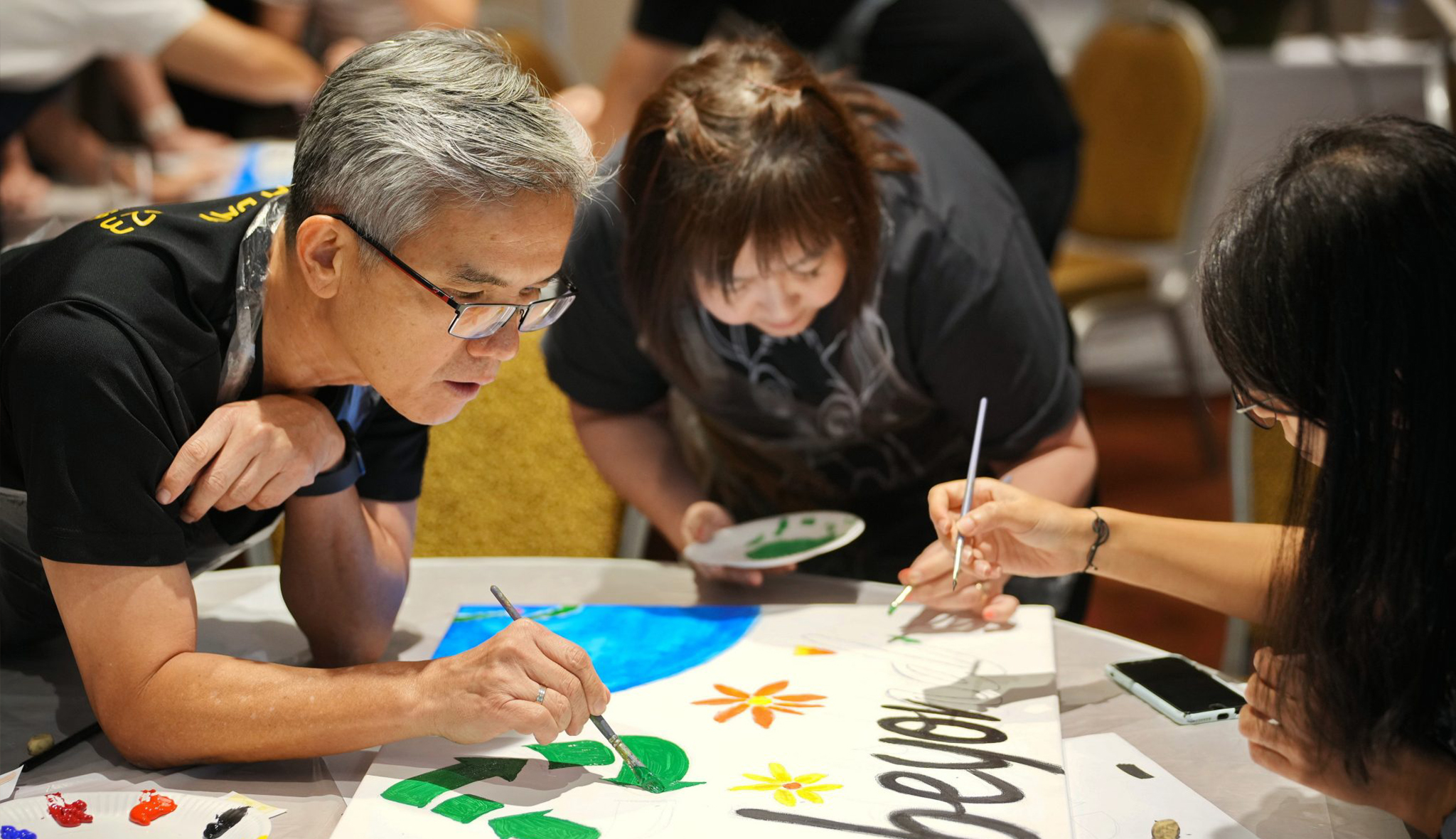Acrylic Painting on Canvas Team Bonding Art Jamming Singapore Visual Arts Centre

























素描从广义上讲,顾名思义,包含有“朴素的描写”之意。它是用铅笔、毛笔、钢笔、碳笔,甚至是现在流行的手写版的画笔等工具做单色的描绘。
但从狭义上讲,素描是一切造型艺术(包括绘画、建筑、雕塑等)的基础训练学科。是通过线条、色块的深浅把我们所画的物象的体积的感觉和空间的感觉真实的表现在平面的纸上。学习美术必须打好素描基础。
素描是一切造型艺术的基础,素描也是独立的艺术形式。
任何一种画作,甚至最简单的线描画,也蕴含了最基础的素描关系。再深一点,连色彩也需要符合基本的素描规律–色相、明度、纯度之间的各种对比与差别,就是素描关系的体现。优秀的画作必须拥有同样优秀的素描关系。就连抽象画也包含在内。素描认知不足,那么,对于速写和色彩的训练也会产生难以避免的艺术认知与艺术表达缺陷。

视觉艺术中心多美歌画室
有时我们去看画展,每当看到大师级的作品,感觉震撼,被作品紧紧抓住,优秀的作品非常吸引人,让人难以忘怀。那么为什么好多作品有强烈的感召力?这与画家长期训练,反复作画、敏锐洞察力有关,每个绘画大师的背后都有一个勤学苦练的故事。

学画和学戏、学舞蹈、学器乐一样,都必须学习基本功,绘画的基本功就是素描 我们为什么要学素描? 我们观察一切事物要有经过素描基本锻炼那样的观察能力。对象的形态、颜色的层次、怎样取得画面上的主次关系、怎样在一个画面上得到平衡,等等。这些问题,学好素描后都能解决。 现在的问题是学了素描以后怎样跳出来,变得更有感染力,要从全局着眼,然后再从局部入手;入手时不是为这局部,而是为了整体。如果你能把整体表现得强有力,表现得更充分,甚至比自然形态的东西更强烈,它就有感染力。感染力从哪里来?不是从繁琐里来,而是从简练中来。从头到尾都要学那种有高度概括力的语言;色彩也好,形象也好,都要有高度的概括力。

速写主要就是通过线条勾画形象。我们为什么除了画明暗法的素描习作还强调要画速写呢?因为通过速写训练,能够用线的处理来更全面地掌握形象和它的运动。有人画素描,眼睛看到什么就画什么,在对象上看不到线就不画线,只画明暗层次,画成照片一般。这样的问题,在速写中就不可能产生。因此要多作速写。一边画素描,一边画速写,二者同时并进。速写,我们不仅应该说它是艺术表现的一种手段,为了发展一个创作意图的画稿,对造型做功夫的研究或习作,它是造型的准备工作的开端,是创造形象的资料;也应该认为速写是艺术家必须毕生坚持的一种作业,是与其他基础功夫同样不可偏废的重要锻炼,纵然没有一定创作目的或计划,艺术家也应该经常面向生活,深入观察,不断积累手和眼的配合,培养自己敏锐的感觉和用形象来反映自己的感受。
画素描要先学静物写生、石膏几何体写生、石膏像写生、人物肖像写生。速写要学习对要绘画物体的线条概括能力,要学习速写树木、山川、河流等风景中的绘画语言,学习静物、人物形状概括能力,学习人物动态等。

视觉艺术中心专业艺术课已在东部Paya Lebar 开设画室,东部马林百列,四美、淡滨尼、加东,勿洛、如切等居住区有好多儿童画画班、儿童创意艺术课,当小朋友们有了儿童画的创意基础后,大概在9岁以上就可以接触专业画画训练,让小朋友在天马行空的想象力绘画中,更加造型生动,表现力更强。



|
||||||||||||||||||||||||||||||||||||||||||
|
||||||||||||||||||||||||||||||||||||||||||||||||||||||||||||||||||||||


SAT |
10:30am - 12:45pm1pm - 3pm
|
SAT |
|
10:30am - 12:45pm1pm - 3pm
|
|




Address:
10 Penang Road, #01-02 Dhoby Ghaut Green,
Singapore 238469
Exit from Dhoby Ghaut MRT Station Exit B and turn left, we are there in 30m!

Address:
AZ@Paya Lebar, 140 Paya Lebar Road, #03-04,
Singapore 409105
Exit from Macpherson MRT Station Exit A and turn left, we are right across the road, 1 minute walk away!
Have any questions? Please drop us an enquiry form and we’ll respond to you as soon as we can!
"*" indicates required fields

10 Penang Road,
#01-02 Dhoby Ghaut Green,
Singapore 238469
140 Paya Lebar Road,
#03-04 AZ@Paya Lebar Building,
Singapore 409015
6255 0711
info@visualartscentre.sg
62550711
67332155
Dhoby Ghaut Art Studio
Monday to Sunday: 11am – 8pm
Closed on Public Holidays, except by appointment.
MacPherson [Office & Storage]
By appointment only
Visual Arts Centre is an exhibition gallery and art studio at Dhoby Ghaut Green supported by the National Parks Board and the National Arts Council.
Since its initiation on 31 January 2016, the Visual Arts Centre Exhibition Gallery has hosted over two hundred international and local art and design exhibitions, boasting a diverse range of art styles and programmes.
Email:
info@visualartscentre.sg
Phone:
+65 6255 0711
+65 6733 2155
Featured Courses 推荐课程
Art Immersion 3 Medium Course 综合媒介绘画课
Drawing & Sketching Course 素描课程
Acrylic Painting Course 丙烯画课程
Watercolour Painting Course 水彩画课程
Oil Painting Course 油画课程
Chinese Ink Painting Course
Trial Sessions 试课
Chinese Calligraphy & Ink Painting
Graffiti Spray Painting Course
Portfolio Preparation Course (Process) 作品集 (DSA)
Portfolio Preparation Course (Process) 作品集 (Diploma)
Professional Manga Drawing & Digital Painting Course
Professional Interior Design & Freehand Rendering Course
Outdoor Urban Landscape Sketching Course
Private Art Classes
Creative Kids Art Immersion Course 儿童创意绘画课程
Holiday Art Courses & Bootcamps
2025: Holiday Art Course for Kids & Teens 儿童和青年假期课程
2025 Kids (6-9YO) Holiday Art Course 儿童假期课程
2025 Teens (10-18YO) Holiday Art Course 青年假期课程
Team Building Art Jamming
Art Jamming Team Bonding Catalogue
Team Bonding
Gala Dinner Art Workshop
Batik Painting Workshop (Mural / Individual)
Graffiti Spray Painting on Canvas Workshop
Kids Birthday Party - Art Jamming
Kids T-Shirt Painting Art Party
Batik Painting Workshop
Graffiti Spray and Paint Workshop
Therapeutic Mental Health Workshops
Art Workshop
Workshops at SAM During SAW 2025
Digital Dreams - Transforming Ideas Into Art
Nude Life Drawing with Artist Guidance
Portrait Life Drawing with Artist Guidance
Chinese Ink Painting
Chinese Calligraphy & Ink Painting
Current & Upcoming Exhibitions
Venue Hire 场地出租
Hire of Visual Arts Centre Exhibition Gallery @ Dhoby Ghaut
Visual Arts Centre Exhibition Gallery @ Dhoby Ghaut
Visual Arts Centre Gallery and Studio @ MacPherson
Special Art Jamming Themes
Chinese New Year Art Jamming
Art Workshops for Singles and Dating
Women's Day
Labour's Day
National Day
Mid Autumn Festival
Deepavali Art Jamming
Halloween Art Jamming
Christmas Art Jamming
View More
Best Team Building Activity
Art Jamming Team Bonding Catalogue
零基础自助绘画(Art Jamming )工作坊
Kids Art Jamming Birthday Party Workshops
艺术生日派对-DIY粘土主题
Art Birthday Party With Diy Clay
Art Birthday Party With Tote Bag Painting 艺术生日派对-画托特包主题
Birthday Party With T-shirt Painting
艺术生日派对-画T恤衫主题
Art Competition and Affordable Art Fair Workshops
(Embracing Nature) Children and Youth Art Competition
Workshops & Fair Activities
Venue Hire
10 tips for a successful pop-up flea market event
Beautiful Space in the City Central
A Perfect Art Venue for Hire
What to consider when renting a venue for your fashion shows and pop-ups?
Art Course
Where to learn Professional Chinese calligraphy course in Singapore?
艺术疗愈如何让你心理更健康
Best Professional Art Courses In Singapore
在新加坡哪里能学专业素描/速写、油画、水彩、丙烯、水墨、艺术作品集准备、儿童美术、儿童青少年书法等专业美术绘画课?
在新加坡哪里学习专业书法课程?学习书法对儿童青少年的好处
View More
Art Portfolio Preparation - DSA (Kids)
凭什么,新加坡乌节路寸土寸金的商业宝地竟给国人当画室? 快!带你去看看!
Singapore Holiday 2025 - Learn Digital Landscape Painting and Manga Drawing
成人画画课就在视觉艺术中心
Applying into Art Schools - How does one build an art portfolio?
Others
Best Professional Manga Drawing Drawing Course in Singapore
对南洋画派新加坡第一代艺术先驱作品的印象
定制贵宾晚宴的艺术项目
Art Buzz: How to Appreciate Art?
《纪念刘抗诞辰111周年—刘抗书画遗作展》
10 Reasons to Learn Drawing and Sketching
View More
Art Therapy Course in Singapore!
Overseas Students Art & Cultural Exchange
Commissioning Custom made portraits/nude life by professional artists
FAQs for Art Portfolio Preparation - DSA, Diploma & Higher Education
Click and get to our WhatsApp
In the Batik Introduction Handkerchief Painting workshop, participants will learn the traditional art of batik, a wax-resist dyeing technique originating from Indonesia. The workshop begins with a brief history and overview of batik, highlighting its cultural significance and various techniques. Participants will then observe a demonstration of applying wax with tjanting tools and dyeing the fabric. Following the demonstration, each participant will design and create their own batik handkerchief, applying wax to create patterns and then dyeing their fabric. The workshop concludes with a group discussion, allowing participants to share their creations and reflect on their learning experience.